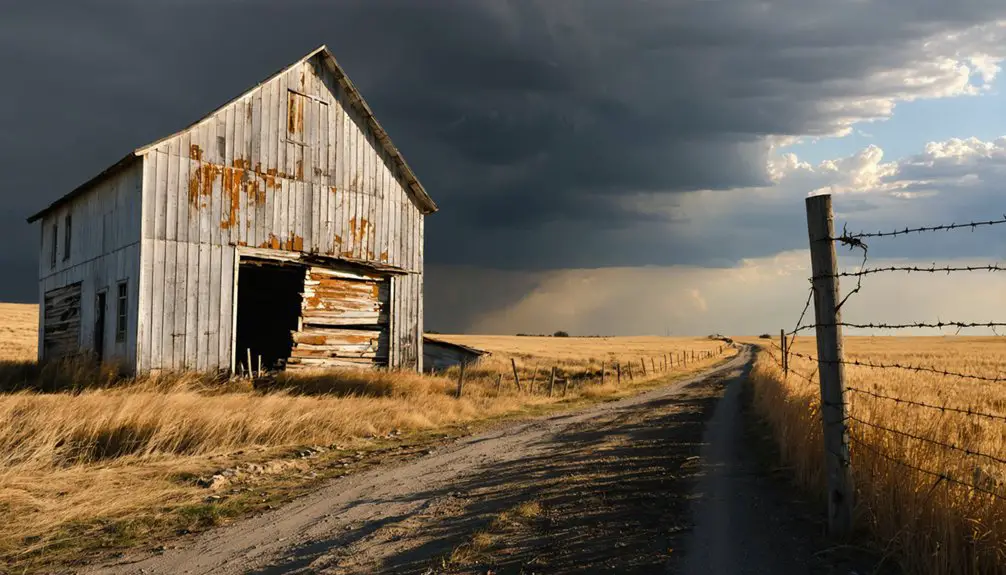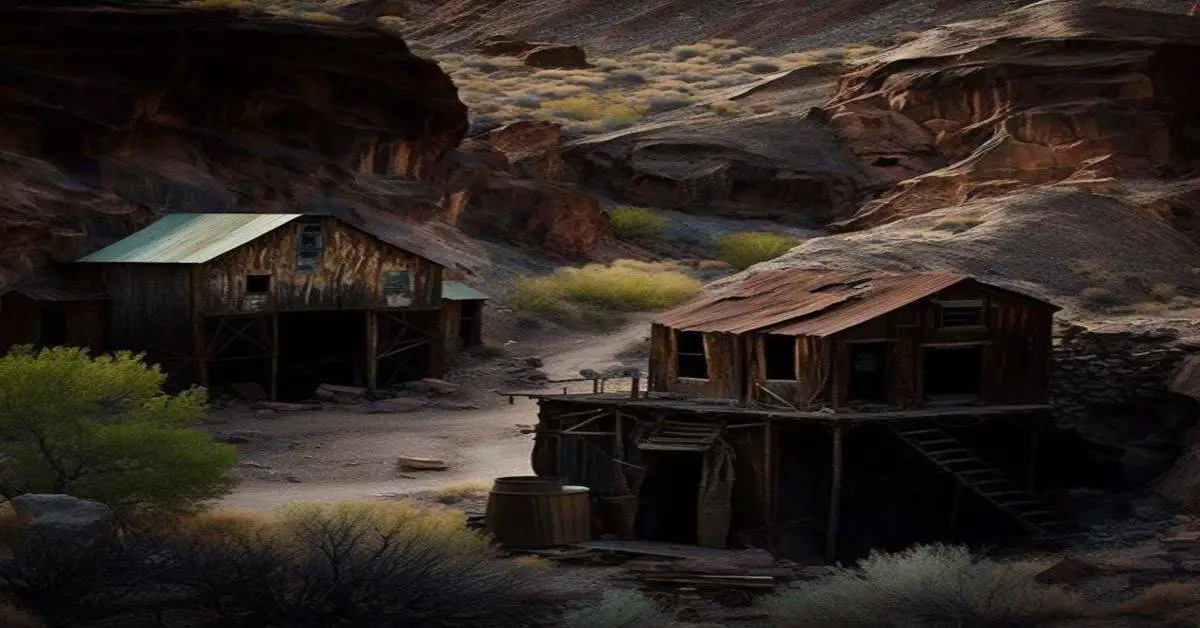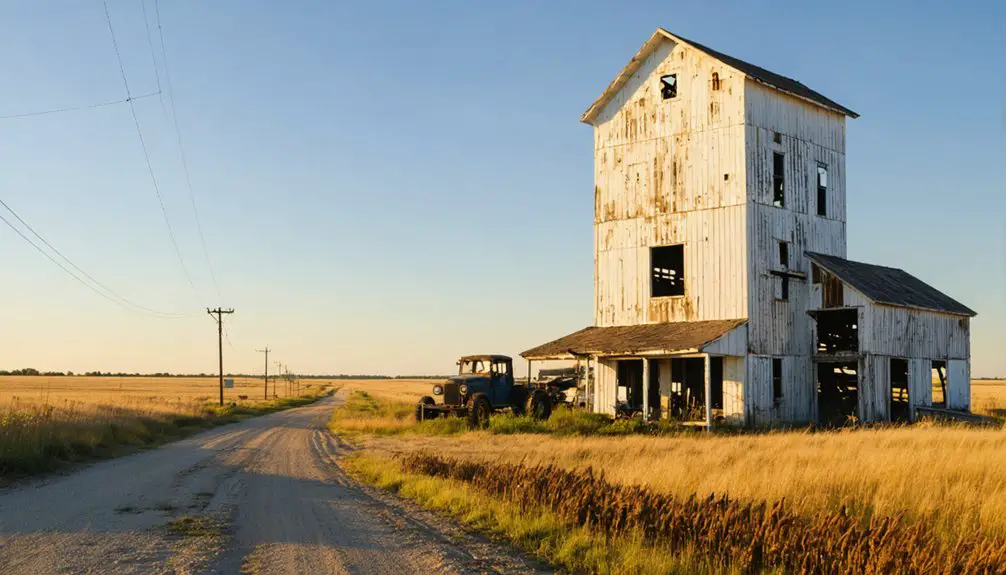You’ll discover Griffin, North Dakota along the former Milwaukee Road railway line, where this cattle town thrived in the early 1900s. Founded as Atkinson in the 1890s, it was renamed in 1908 to honor railroad agent Henry T. Griffin. The town peaked at 67 residents, with bustling stockyards and steady traffic from the Yellowstone Trail. Today, three weathered structures – a schoolhouse, boxcar, and barn – stand as silent witnesses to Griffin’s railroad and agricultural heritage.
Key Takeaways
- Founded in the 1890s along the Milwaukee Road railroad, Griffin peaked at 67 residents before becoming a ghost town.
- Three historic structures remain today: a weathered schoolhouse, abandoned boxcar, and worn barn, all facing deterioration.
- The 1936 drought and dust storms marked the town’s final decline, forcing residents to abandon farms and relocate.
- Griffin served as a crucial stop along the Yellowstone Trail, featuring yellow-painted rocks and arrow signs for travelers.
- Originally named Atkinson, the town was renamed Griffin in 1908 to honor railroad agent Henry T. Griffin.
The Rise and Fall of Griffin
While many North Dakota towns sprang up organically around farming communities, Griffin emerged in the 1890s as a calculated business venture along the Milwaukee Road railroad.
Originally named Atkinson, you’ll find its story intertwined with the economic opportunities brought by both the railroad and the historic Yellowstone Trail, the region’s first transcontinental highway. The site boasted some of the largest stockyards in Bowman County, attracting significant cattle trade to the area. The town’s development began with William Atkinson establishing a grocery store and saloon that became a center for local commerce.
Despite ambitious plans and hundreds of plotted lots, Griffin’s community dynamics never quite matched its founders’ vision. The town peaked at just 67 residents, with most activity centered around stockyards and cowboys rather than permanent settlers.
When drought struck in 1936, it dealt a devastating blow to the already fragile settlement. Soon, the streets were plowed under for farming, and Griffin’s brief chapter in North Dakota’s history came to an end.
Life Along the Yellowstone Trail
As the Yellowstone Trail cut through Griffin in the early 1900s, this pioneering transcontinental route brought a steady stream of motorists seeking adventure between Plymouth Rock and Puget Sound.
You’d find yellow-painted rocks and arrow signs guiding travelers through the rural countryside, while local information bureaus helped motorists navigate the changing road conditions. The slippery mud roads made travel especially challenging during wet weather.
The Trail transformed Griffin’s rural connectivity, linking this small prairie town to a nationwide network of improved roads.
Local businesses benefited from passing tourists who’d stop to rest, check road conditions by telephone, or seek directions from posted maps.
This grassroots transportation project represented more than just a road – it was your gateway to freedom, connecting remote communities like Griffin to distant markets and the emerging automobile culture of early 20th-century America.
The route’s extensive reach through thirteen American states made it a vital artery for cross-country travelers and commerce.
Ghost Town Structures Today
If you visit Griffin today, you’ll find three key structures that tell the story of this once-bustling prairie town: a weathered schoolhouse showing the effects of harsh Dakota seasons, an abandoned railroad boxcar hinting at the town’s rail-line past, and a worn barn speaking to the area’s agricultural heritage.
The schoolhouse, though relocated from its original spot, remains the most prominent remnant with its historic wooden shingles still visible through years of decay. During its heyday, the town was a major hub for stockyard operations in Bowman County. Originally established as Atkinson, the town was renamed Griffin in 1908 to honor a Milwaukee Road railroad official.
These deteriorating landmarks stand as silent witnesses to Griffin’s evolution from an early 1900s frontier settlement to a true ghost town, with no maintained infrastructure or current residents.
Decaying Schoolhouse Remnants
Once standing proudly as the Atkinson School two miles northwest of Griffin, the deteriorating schoolhouse now serves as a poignant reminder of North Dakota’s rural education reforms in the 1920s.
You’ll find remnants of wooden shingles and a distinct building addition that speak to the schoolhouse’s history as one of Bowman County’s four consolidated schools, marking the shift away from one-room education.
Until early 2023, you could spot the original foundation at its first location, but it’s since been cleared for farming.
The structure, which once bustled with students arriving by mule cart from scattered rural homesteads, now stands relocated closer to Griffin.
Like many abandoned prairie schools, time and weather continue to claim the building’s remaining wooden bones.
Located along the historic Yellow Stone Trail, the schoolhouse remains one of the few standing structures in this ghost town.
Abandoned Railroad Boxcar
Among Griffin’s remaining structures, a solitary railroad boxcar stands as a tribute to the town’s Milwaukee Road heritage. You’ll find this wooden relic weathered but intact, one of the few surviving pieces from Griffin’s bustling railroad era.
Once essential to the town’s grain transport operations, it’s now marked by decades of exposure and hints of its past life, including internal oil residues from later storage use. Similar to the French Gratitude Train boxcars that symbolized post-war friendship, this historic carrier represents an important era of American railroad history.
The boxcar’s significance stretches back to when Griffin, originally named Atkinson until 1908, thrived as a key railroad stop along Highway 12.
While most wooden railroad buildings burned or vanished by 1930, this boxcar persists as a tangible connection to the town’s peak years, when Milwaukee Road’s expansion transformed North Dakota’s rural landscape through essential grain shipments and economic growth. Like nearby ghost town Gascoyne, Griffin exemplifies the broader pattern of rural depopulation that has reshaped the American Midwest.
Historic Barn Remains
The towering white barn of Griffin stands today as a precarious shell of its former grandeur, with its weathered frame perched unsteadily on stilts above a flooded concrete cellar.
As one of Bowman County’s largest stockyards during Griffin’s heyday, this deteriorating structure once played a crucial role in the region’s agricultural heritage, serving both railroad and livestock operations in the early 1900s. This architectural style mirrors the design of Steen H. Nelson’s barn, which was also positioned strategically along a major railway line.
You’ll find traditional wooden construction methods throughout, including what’s left of the original frame, though barn preservation efforts have been nonexistent.
The concrete foundation, unusually robust for its era, now caves in beneath the weight of time and water damage.
Like many remnants of Griffin’s past, this rare example of rural North Dakota’s agricultural architecture faces imminent collapse without intervention.
Tales From the Old West
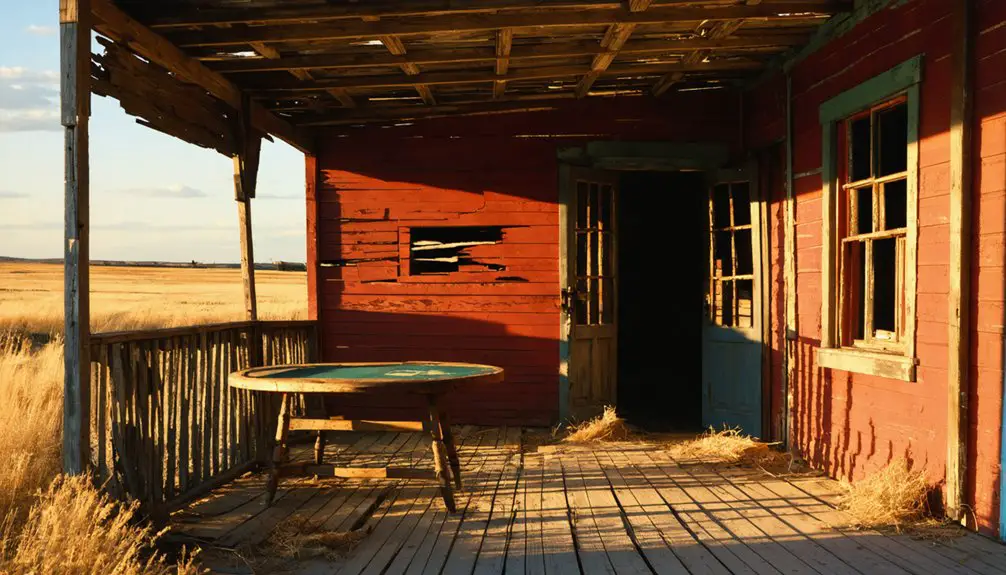
Situated along the Milwaukee Road railroad line, Griffin’s history echoes the classic tales of Old West ambition and resilience.
You’ll find frontier legends woven into the fabric of this once-bustling agricultural hub, where cowboy folklore and railroad stories merged amid the vast Dakota plains. The town’s stockyards and grain elevators stood as monuments to the pioneering spirit that defined the American West.
- In 1908, when the town changed its name to honor railroad agent Henry T. Griffin, local ranchers drove massive cattle herds through streets lined with hopeful merchants.
- During peak years, railroad workers and farmers gathered at the section houses, sharing tales of drought, triumph, and frontier life.
- The 1936 drought brought dramatic scenes of dust storms and desperate cattle drives, marking the town’s final chapter in Old West history.
Natural Forces and Abandonment
Natural forces conspired against Griffin’s survival during the 1930s, when severe drought conditions and relentless dust storms battered the semi-arid Dakota plains.
You’ll find that these climatic challenges hit hardest in 1936, pushing already-struggling farmers to abandon their dreams of prosperity. The harsh winters and poor soil conditions didn’t help either, making it nearly impossible to maintain viable crops or livestock operations.
As nature reclaimed the land, you can see how agricultural decline transformed Griffin’s landscape. The town’s original streets have vanished beneath plowed fields, while prairie grasses steadily march across abandoned farmland.
Without human maintenance, wooden structures fell prey to sun bleaching and rot. Today, the remaining buildings stand as weathered sentinels, slowly surrendering to the persistent forces of erosion and time.
Exploring Griffin’s Remains
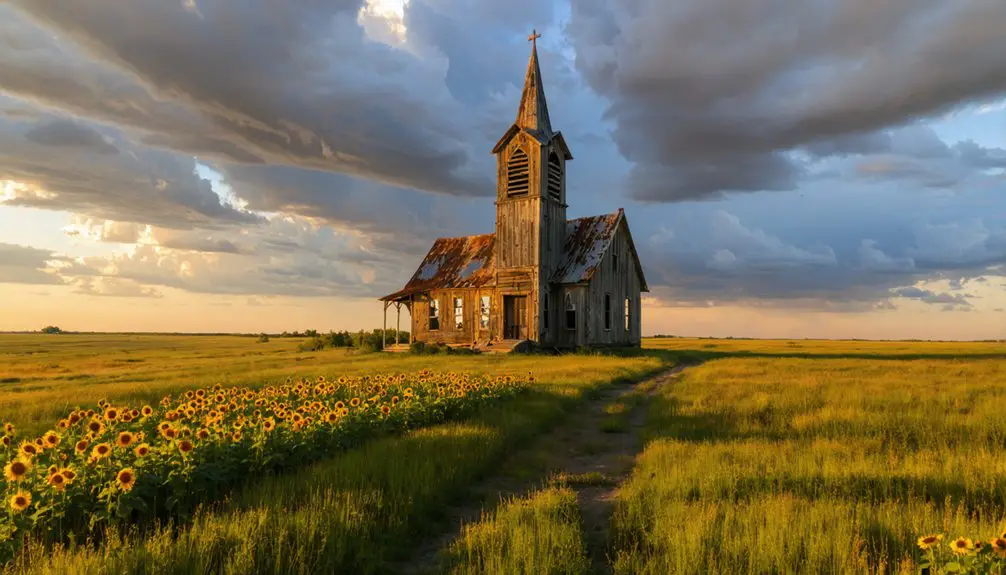
Walking through Griffin’s remains today, you’ll encounter a haunting collection of weather-worn structures that tell stories of its bustling past.
For urban exploration enthusiasts and historical preservation advocates, the site offers a raw glimpse into North Dakota’s railroad era, accessible via a short walk north of Highway 12.
- The original schoolhouse stands proudly with its wooden shingles intact, revealing layers of early additions that chronicle the town’s growth.
- Twin grain elevators tower above the landscape, marking Griffin’s location and its agricultural heritage.
- A large barn with a flooding concrete cellar, abandoned trailer houses, and potential remnants of the general store await your discovery.
Be cautious exploring these deteriorating structures, as many show significant decay with sagging floors and unstable foundations.
Prairie Town Legacy
Founded in the 1890s by William “Oneeyed Bill” Atkinson, Griffin emerged as an essential commerce hub along North Dakota’s Milwaukee Road railway line.
You’ll find the town’s legacy woven into the prairie traditions of the Coteau des Prairies, where Scandinavian and German immigrants carved out new lives from the fertile soil.
Their immigrant stories echo through Griffin’s rich past, from the lively saloon that sheltered travelers during fierce blizzards to the progressive Atkinson School that marked rural education reform.
While the railroad brought prosperity and connected Griffin to the Pacific coast, it’s the cultural mosaic of these European settlers that defined the region’s character.
Though abandoned today, Griffin’s remaining structures stand as a testament to the pioneering spirit that transformed the Dakota prairie.
Frequently Asked Questions
Are There Any Documented Paranormal Activities or Ghost Sightings in Griffin?
You won’t find documented ghost stories or spectral sightings here – there’s no historical record, local lore, or modern reports of paranormal activity in this quiet prairie settlement’s remains.
What Happened to the Original Residents and Their Descendants?
You’ll find most original residents moved to nearby towns like Bowman or Rhame when Griffin declined. Their descendants’ stories reveal they stayed within North Dakota, maintaining farms or settling in surrounding agricultural communities.
Were Any Movies or Television Shows Ever Filmed in Griffin?
You won’t find any film history of movies or TV shows filmed in this location. While ghost stories and explorers have documented the remains, no professional productions have used the site.
Is Metal Detecting or Artifact Collecting Allowed on the Griffin Site?
You can’t legally metal detect or collect artifacts at Griffin since federal and state metal detecting laws protect archaeological sites. You’ll need special permits for research, not recreational artifact preservation.
What Was the Average Property Value of Lots During Griffin’s Peak?
Like a faded photograph, historical property values in Griffin remain unclear. You won’t find documented lot appraisals, though regional context suggests modest frontier prices during the town’s 1910s peak.
References
- https://www.legendsofamerica.com/griffin-north-dakota/
- https://www.youtube.com/watch?v=-E2DA6Ryd1g
- https://ghostsofnorthdakota892857007.wordpress.com/category/griffin-nd/
- https://www.onlyinyourstate.com/experiences/north-dakota/vacant-ghost-town-rural-nd
- https://www.youtube.com/watch?v=q8bFVkNw6I4
- https://yellowstonetrail.org/wp-content/uploads/2024/10/Arrow01.pdf
- https://www.wpr.org/history/what-yellowstone-trail-and-where-does-it-go
- https://worldautotour.com/history-of-the-yellowstone-trail/
- https://historysifter.com/2019/01/11/the-yellowstone-trail/
- https://en.wikipedia.org/wiki/Yellowstone_Trail
